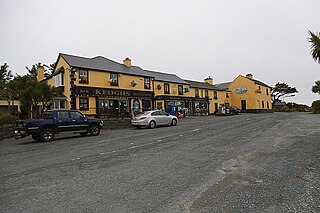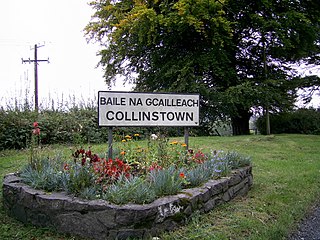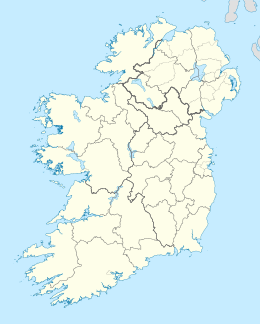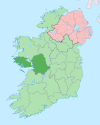
Augustus Joseph Nicholas Burke was an Irish artist and an Academician of the Royal Hibernian Academy (RHA).

Connemara is a region on the Atlantic coast of western County Galway, in the west of Ireland. The area has a strong association with traditional Irish culture and contains much of the Connacht Irish-speaking Gaeltacht, which is a key part of the identity of the region and is the largest Gaeltacht in the country. Historically, Connemara was part of the territory of Iar Connacht. Geographically, it has many mountains, peninsulas, coves, islands and small lakes. Connemara National Park is in the northwest. It is mostly rural and its largest settlement is Clifden.

Clifden is a coastal town in County Galway, Ireland, in the region of Connemara, located on the Owenglin River where it flows into Clifden Bay. As the largest town in the region, it is often referred to as "the Capital of Connemara". Frequented by tourists, Clifden is linked to Galway city by the N59.
The Conmhaícne Mara or Conmaicne Mara, were an early people of Ireland. Their tuath was located in the extreme west of County Galway, Republic of Ireland, giving their name to Connemara, an anglicised form of Conmhaicne Mara.

Patrick James Whelan was a suspected Fenian supporter executed following the 1868 assassination of Irish journalist and politician Thomas D'Arcy McGee.

Ballyconneely is a village and small ribbon development in west Connemara, County Galway Ireland.

Ballysadare, locally also Ballisodare, is a town in County Sligo, Ireland. It is about 7 kilometres south of Sligo town. The town developed on an important crossing of the Owenmore River.

Collinstown is a village in north County Westmeath, situated on the R395 regional road overlooking Lough Lene. It lies 18 km (11 mi) northeast of the county town of Mullingar and had a population of 356.

The Archdiocese of Tuam is an ecclesiastical territory or archdiocese of the Catholic Church located in western Ireland. The archdiocese is led by the Archbishop of Tuam, who serves as pastor of the mother church, the Cathedral of the Assumption and Metropolitan of the Metropolitan Province of Tuam. According to tradition, the "Diocese of Tuam" was established in the 6th century by St. Jarlath. The ecclesiastical province, roughly co-extensive with the secular province of Connacht, was created in 1152 by the Synod of Kells.

Claddaghduff is a village in County Galway, Ireland. It is located northwest of Clifden, the gateway to Omey Island.

Saint Féchín or Féichín, also known as Mo-Ecca, was a 7th-century Irish saint, chiefly remembered as the founder of the monastery at Fore (Fobar), County Westmeath.
Dáithí Mícheál Ó Sé is an Irish television presenter. He currently hosts RTÉ One's Today, alongside Maura Derrane. He is also the current host of the Rose of Tralee and hosts a chat show on TG4 every Thursday night, Seal Le Dáithí.
Sean Corcoran MIDI is an Irish visual artist noted for his stained glass, mosaics, wooden sculpture, and sand art.
Island Eddy is a small, depopulated island at the inner, eastern end of Galway Bay, Ireland.
Ardoileán or Ard Oileán, known in English as High Island, is a small island off the northwest coast of Connemara in County Galway, Ireland. It was once the site of an early Irish monastic community.
Mícheál or Micheál Mac Suibhne was an Irish language bard from the Connemara Gaeltacht.
Gormgal of Ardoileán was an Irish cleric.

Renvyle or Rinvyle is a peninsula and electoral division in North-West Connemara in County Galway, close to the border with County Mayo in Ireland.















